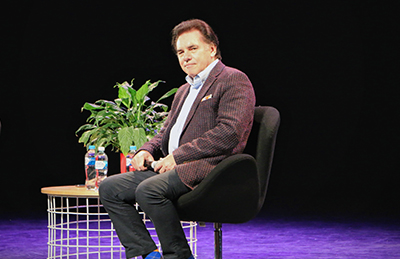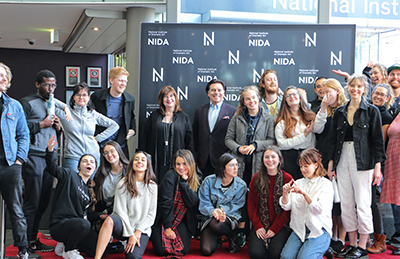NIDA welcomed Lyndon Terracini, Artistic Director of Opera Australia, as part of our Change-makers and Innovative Storytellers Series.

Photo: Lyndon Terracini talks about the future of opera at NIDA with NIDA CEO/Director Kate Cherry.
NIDA’s Change-makers and Innovative Storytellers Series continued this week when we welcomed Lyndon Terracini, Artistic Director of Opera Australia. The head of Australia’s national opera company and resident at the Sydney Opera House has been at Opera Australia since 2009, which under his leadership has doubled in turnover and audience.
Prompted by Master of Fine Arts (Design for Performance) students, Lyndon talked enthusiastically about the digital design of the current Opera Australia (OA) production of Verdi’s Aida. Italian director Davide Livermore, renowned for high-tech sets that create impressive, three-dimensional backdrops using sophisticated LED lighting effects and video projections, has brought the world of Egypt to the Joan Sutherland Theatre with ten panels that can travel and move 360 degrees.
Lyndon said that OA were increasingly investing in digital design technology, for example using the zactrack® lighting auto following system for performers on stage. He also talked about ghost gauzes, using projections to create 3D objects on stage, and using LED panels in the audience to create an immersive experience.
‘In terms of the future with this technology, as well as it looking extraordinary in the theatre, we will be able to make productions in a more economical way. We are not competing with other opera companies, we are competing with Netflix: our audience wants to have a complete experience and we are trying to catch up with that. ‘
Lyndon said that physical sets will also continue to be used: ‘You also have to not allow the technology to take over everything, but the developments in design are really exciting and it’s a fantastic space to be in the present time. We don’t know where it will end, but it will be pretty phenomenal. For example, in a digital production of Wagner’s Ring Cycle, we could create things like the fire curtain.’
‘There is no artform without an audience’
Lyndon’s talent for leadership helped him to create the outstanding Northern Rivers Performing Arts theatre company. He has also been the Artistic Director of Queensland Music Festival and Brisbane International Arts Festival, on the International Jury for the Venice Biennale for Music and Savonlinna Opera Festival. In 2014 his service to the performing arts as an opera performer, director and administrator was recognised with a Member of the Order of Australia (AM) in the Queen’s Birthday Honours.
He knows how to keep an opera company going, when the artform is under threat all over the world. He famously said in an interview in The Australian: ‘Without an audience, you haven’t got a company, and without that the artform dies. The reality is that opera companies all over the world are closing virtually by the day, and we’re not going to do that. ‘
In response, Opera Australia last year presented 600 performances to more than half a million people and employs over 500 people presenting, creating, touring, marketing and broadcasting opera and engaging people across communities in its wonders.
Lyndon said that Opera Australia was unusual in that it survives on 75% box office revenue for its budget – The New York Met has 34% box office revenue and companies in Germany sit at 10%.
‘Opera worldwide is in a huge crisis,’ he said. ‘We depend on people buying tickets. In the last century, opera theatres were built to house new repertoire for opera companies before movies came into play. The situation now is: if you don’t grow, you die.’
Diversity and role casting
Answering questions about diversity in roles, Lyndon explained that OA have not shied away from casting singers from all around the world, and often employ Korean singers and Russian singers. They attempt to cast appropriately at all times, for example Madame Butterfly is now cast with Asian singers, although it’s sometimes difficult to find the performer with the requisite singing skills.
‘For Aida, there are only five people in the world who can sing that role, so it becomes difficult to choose who to cast.’
Sourcing funds and new audiences
Sourcing new works and projects is an essential part of Lyndon’s role, and with that comes the responsibility to sell the project to sponsors and his Board.
He has been instrumental in setting up the Handa Opera on Sydney Harbour which was only made possible by the support of Japanese businessman Dr Handa. ‘Once we secured that funding we could access Tourism NSW and hoped we could sell $7 million worth of tickets in a month which we fortunately were able to do. The role of the Artistic Director now is like a film producer, where you need to access the funds to get your project up. You are responsible for everything that the company does.’
Lyndon said that a big part of their audience growth at Handa Opera (including 50% of first-timers) has come from China, with surtitles in both English and Mandarin now used at the Sydney Opera House.
What is the future of Australian opera? ‘An Australian opera like The Rabbits which had gorgeous songs, speaks genuinely to a large audience and addresses Indigenous issues. It is about who we are as Australians, it was a huge success.’
‘I don’t think we have found our Australian operatic identity yet. So far we have slavishly followed other models of music: we need to be brave enough to write operas that people want to come and see. That is what Opera Australia will be doing in the future.’

